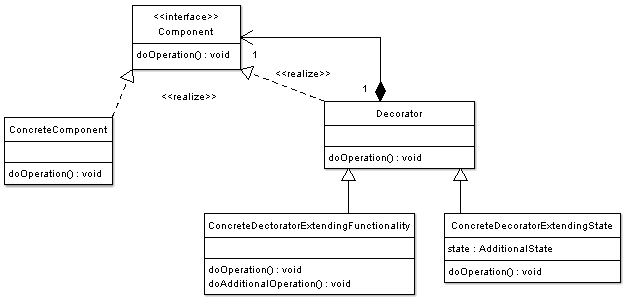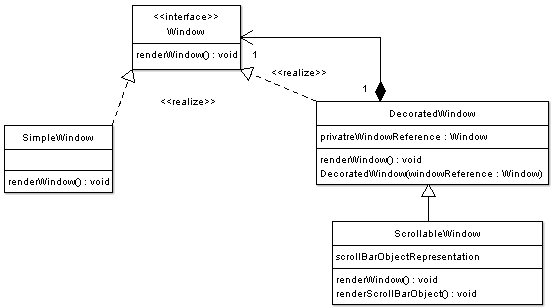Decorator Pattern
Motivation
Extending an object's functionality can be done statically (at compile time) by using inheritance however it might be necessary to extend an object's functionality dynamically (at runtime) as an object is used.
Consider the typical example of a graphical window. To extend the functionality of the graphical window for example by adding a frame to the window, would require extending the window class to create a FramedWindow class. To create a framed window it is necessary to create an object of the FramedWindow class. However it would be impossible to start with a plain window and to extend its functionality at runtime to become a framed window.
Intent
- The intent of this pattern is to add additional responsibilities dynamically to an object.
Implementation
The figure below shows a UML class diagram for the Decorator Pattern:

The participants classes in the decorator pattern are:
- Component - Interface for objects that can have responsibilities added to them dynamically.
- ConcreteComponent - Defines an object to which additional responsibilities can be added.
- Decorator - Maintains a reference to a Component object and defines an interface that conforms to Component's interface.
- Concrete Decorators - Concrete Decorators extend the functionality of the component by adding state or adding behavior.
Description
The decorator pattern applies when there is a need to dynamically add as well as remove responsibilities to a class, and when subclassing would be impossible due to the large number of subclasses that could result.
Applicability & Examples
Example - Extending capabilities of a Graphical Window at runtime

Source: Click here to see java source code
In Graphical User Interface toolkits windows behaviors can be added dynamically by using the decorator design pattern.
Specific problems and implementation
Graphical User Interface Frameworks
GUI toolkits use decoration pattern to add functionalities dynamically as explained before.
Related Patterns
- Adapter Pattern - A decorator is different from an adapter in that a decorator changes object's responsibilities, while an adapter changes an object interface.
- Composite Pattern - A decorator can be viewed as a degenerate composite with only one component. However, a decorator adds additional responsibilities.
Consequences
- Decoration is more convenient for adding functionalities to objects instead of entire classes at runtime. With decoration it is also possible to remove the added functionalities dynamically.
- Decoration adds functionality to objects at runtime which would make debugging system functionality harder.
Known Uses:
- GUI toolkits as has been previously explained.